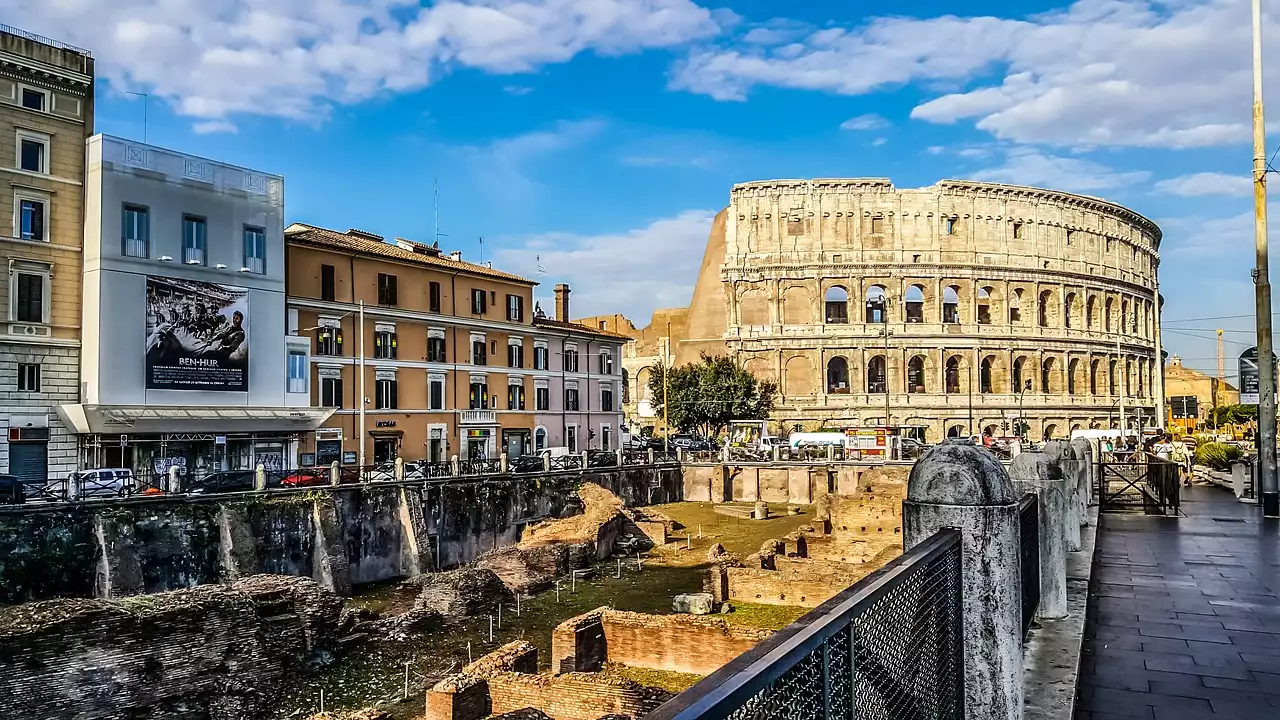The Colosseum is one of the most well-known landmarks in Rome. It’s an amphitheater located in the center of the city and built between 70 and 80 AD. It was commissioned by the Roman emperor Vespasian, and it soon became a famous site for gladiator fights. It could hold up to 50 thousand spectators at once, making it an ideal location for these bloody spectacles. The Colosseum is one of the best-preserved structures from ancient Rome. Although it was used as an arena until around 519 AD, today we know it as a symbol of imperial power rather than a place for fighting animals or gladiators. Let’s take a look at its history (and some interesting facts) in this article!
The Design of the Colosseum
The Colosseum was built with two stories: a ground level and a basement. On the ground floor, there were three main entrances, several shops, and an opening for wild animals to be brought in. The upper level had seats for the spectators and a retractable awning that could be drawn to provide shade. Perhaps the most striking feature of the Colosseum is the 80-meter-high (262-foot-high) facade, which is the largest ever built in the Roman Empire. The designers of the Colosseum sought to impress visitors from the moment they got a glimpse of the building. The Colosseum has a circumference of 590 meters (1,936 feet), with a diameter of 188 meters (623 feet), and a maximum depth of 50 meters (164 feet). Its interior could accommodate as many as 100,000 spectators.
Who Built the Colosseum?
The Colosseum was built by a crew of approximately 100,000 people, most of whom came from around the Roman Empire and were either enslaved or forced to work. Other than that, we don’t know a whole lot about who exactly built the Colosseum. Historians have made guesses, but these are mostly based on the assumption that the emperor would have wanted to employ people who could help him to legitimize his rule. This means that builders from Rome were likely chosen over people from other parts of the empire.
Gladiators in Ancient Rome
Gladiatorial fights in Rome were at their most popular during the reign of Emperor Nero (54-68 AD). The emperor himself even participated in some of these fights. The gladiators themselves came from difficult backgrounds; many of them were enslaved prisoners of war, and others were condemned criminals. Some historians believe that it was the emperor’s way of showing the public that he was not afraid of death. The gladiatorial fights in Rome were extremely popular, and they made the emperor a lot of money. The Colosseum was originally built with money from the imperial family’s private funds. The emperor Vespasian didn’t ask the Senate or the people of Rome for the money, but he did promise them a share of the profits once the building was finished.
Why was it built?
The Colosseum was built in the center of the city because it was meant to be a source of entertainment for the public during the long and harsh Roman winter. The Colosseum was used to host public spectacles that were meant to be entertaining as well as to serve as a form of moral education. Blood sports such as gladiator fights, wild animal hunts, and public executions were meant to be viewed by all sections of society as a form of edification.
The Colosseum in Today’s Rome
The Colosseum is one of the most iconic symbols of Ancient Rome. It’s been centuries since the Colosseum was used as an arena for gladiatorial fights. Today, it welcomes millions of tourists every year who come to see the remains of this ancient structure. The Colosseum has been restored, and it’s now a major landmark in the city of Rome. It’s a popular place for people to visit, and it’s also used for cultural events and concerts. The Colosseum is a UNESCO World Heritage Site. It’s a popular tourist attraction, and it’s one of the most visited sites in the world. Over 10 million people visit the Colosseum each year.
The Colosseum as a symbol of Imperial Power
The Colosseum is a symbol of Imperial power because it represents the unlimited power of the Roman emperors. The emperors and their families often used public spectacles to prove their power over the people and their ability to indulge in decadent pleasures. The Colosseum was built over the seats of a lake, which is why it was built on a very high level and has no foundations. It was meant to prove the power of the Roman emperors because they could have built it on any level they wanted, but they chose to build it on the highest level in the city. The Colosseum also has a large, 80-meter-high (262-foot-high) facade, which is the largest ever built in the Roman Empire. The designers of the Colosseum sought to impress visitors from the moment they got a glimpse of the building. And that’s how the Colosseum was built and how it came to be. It’s a symbol of the power of the Roman emperors, and it’s one of the best-preserved buildings from ancient Rome.


 Traditional English Game of Rounder’s
Traditional English Game of Rounder’s
 How Classical Greek Culture Continues to Inspire Art, Literature, and Philosophy Today
How Classical Greek Culture Continues to Inspire Art, Literature, and Philosophy Today The Best Greek Island for First-Time Visitors
The Best Greek Island for First-Time Visitors The Wall of China and The Great Wall
The Wall of China and The Great Wall The Splendor of The Great Pyramids of Giza
The Splendor of The Great Pyramids of Giza The Mysteries of Stonehenge and its Meaning
The Mysteries of Stonehenge and its Meaning St. Peters Basilica - the Vatican in Rome
St. Peters Basilica - the Vatican in Rome